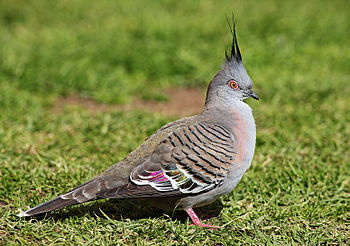Talk:Crested pigeon
File:Pigeon-Crested.jpg to appear as POTD soon[edit]
Hello! This is a note to let the editors of this article know that File:Pigeon-Crested.jpg will be appearing as picture of the day on December 17, 2011. You can view and edit the POTD blurb at Template:POTD/2011-12-17. If this article needs any attention or maintenance, it would be preferable if that could be done before its appearance on the Main Page so Wikipedia doesn't look bad. :) Thanks! howcheng {chat} 19:36, 16 December 2011 (UTC)
Name[edit]
- They are commonly misidentified as the Topknot Pigeon.
That uncited statement seems highly unlikely.
To the contrary, the common name for this bird is the "top-notch pigeon", which I presume some prescriptivist has misheard and erroneously confused for a misidentification.
I'm not sure the best way to cite common names, so how about [1]. (A misidentification implies that, when presented with a specimen, a person could be confused as to which of those two species it belonged to. That's hardly going to be the case here, even more so because the most distinctive and obvious feature of the topnotch is its take off sound which I presume the topknot does not share - in addition to looking completely different, one would sooner confuse it for a crowned pigion or something. It would not be a misidentification for two different animals in two different regions to have names that happen to be the same.) Cesiumfrog (talk) 23:29, 29 April 2012 (UTC)
Inconsistency in text[edit]
I find it hard to reconcile the statements in this portion of the text:
They are generally solitary. Although they can be seen in pairs, they can be highly social and tend to be seen in packs.
If they are generally solitary, how can they tend to be seen in packs? Certainly they are pretty common birds around us on Sydney's Upper North Shore, often in small groups of 3 or 4 foraging in open areas. — Preceding unsigned comment added by GeeDee (talk • contribs) 03:30, 24 June 2017 (UTC)
Crested pigeon[edit]
So you're one of these alleged experts who doesn't believe a localised name for a bird unless you already know about it? Cjmerrett (talk) 06:03, 17 October 2018 (UTC)





